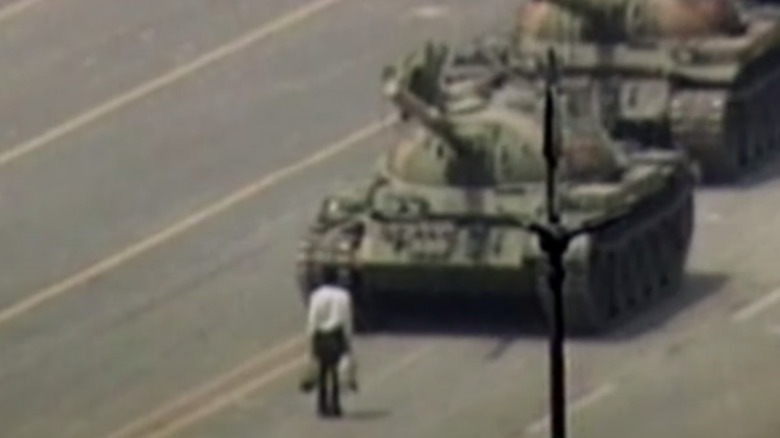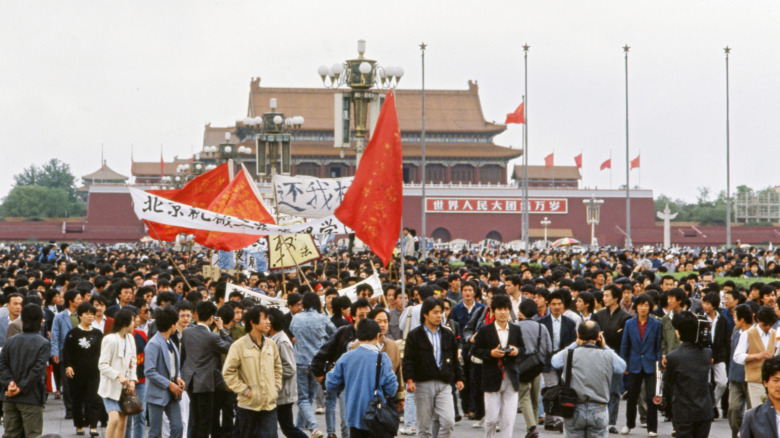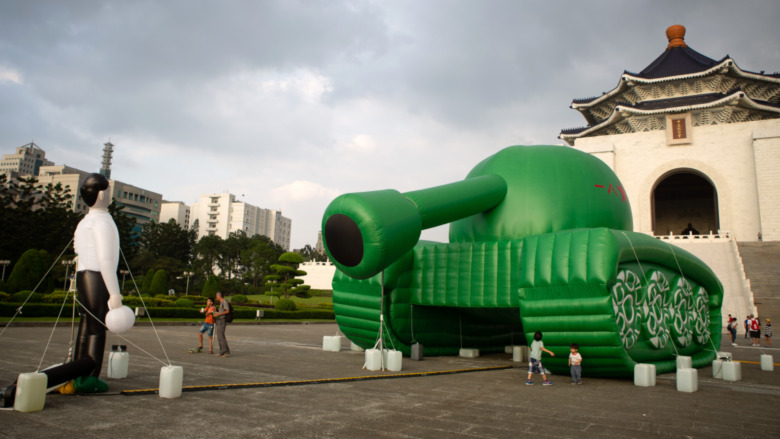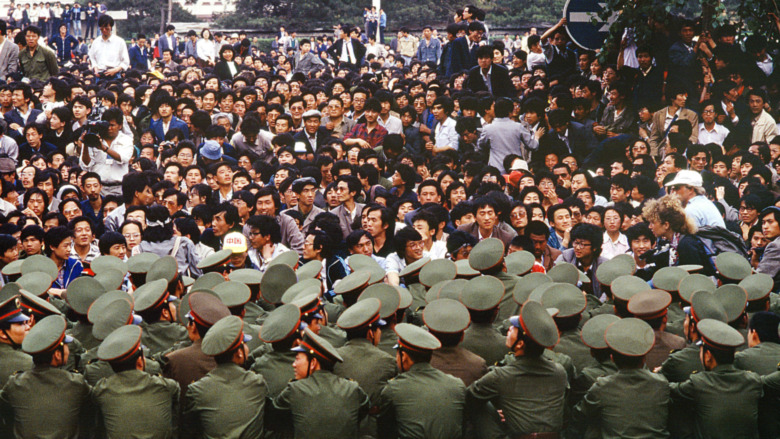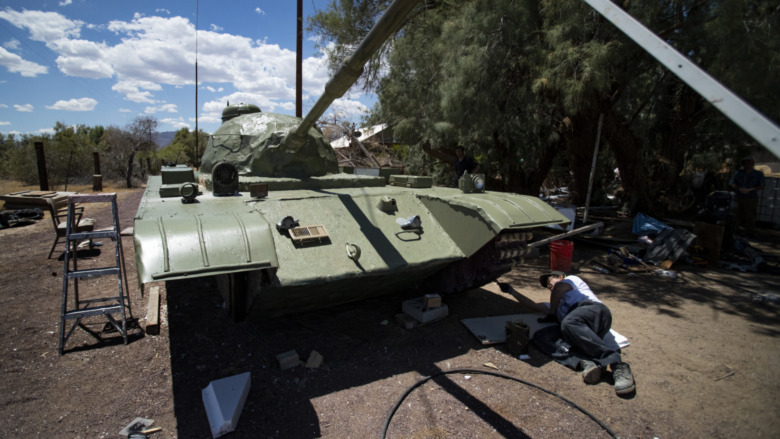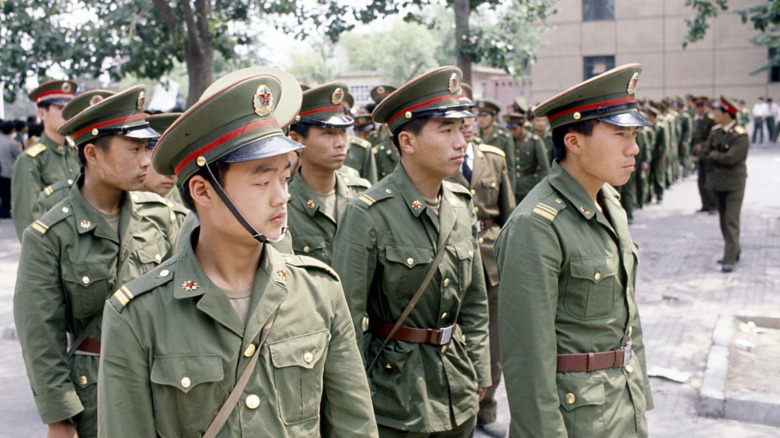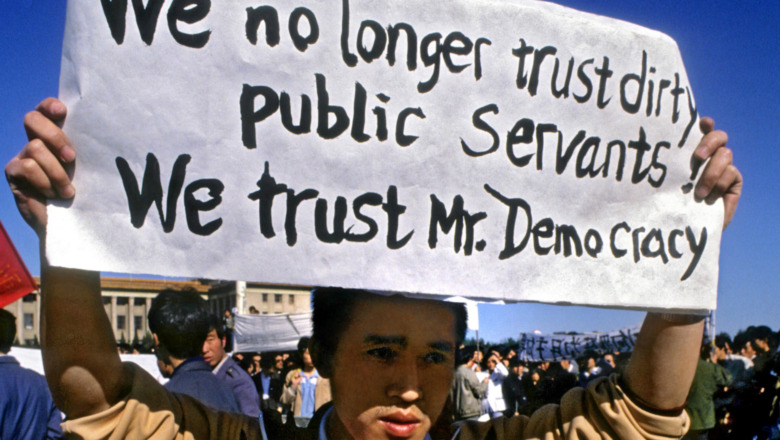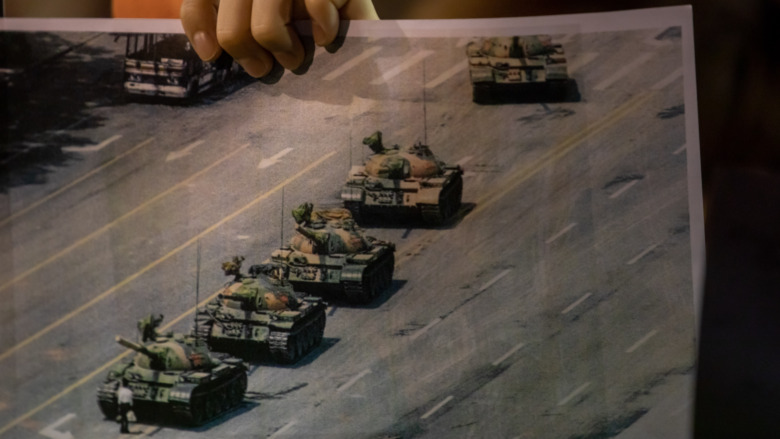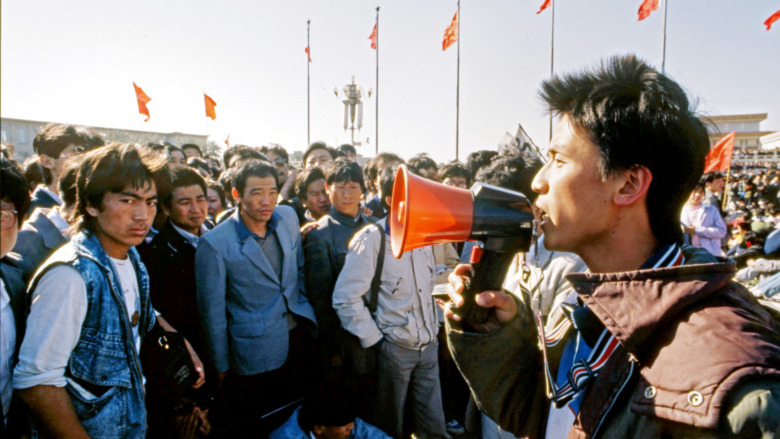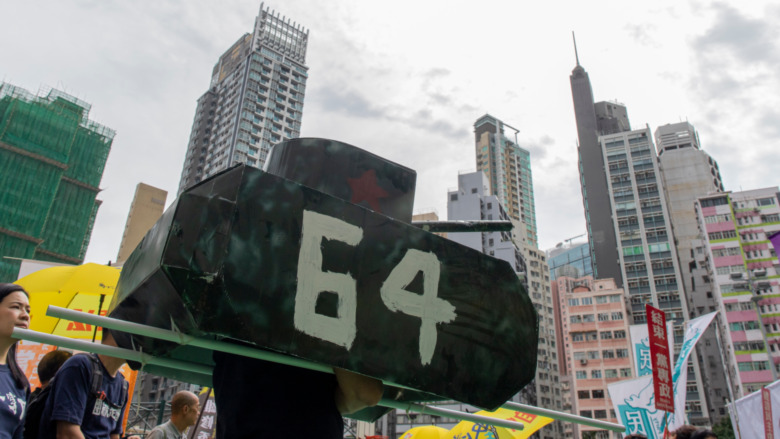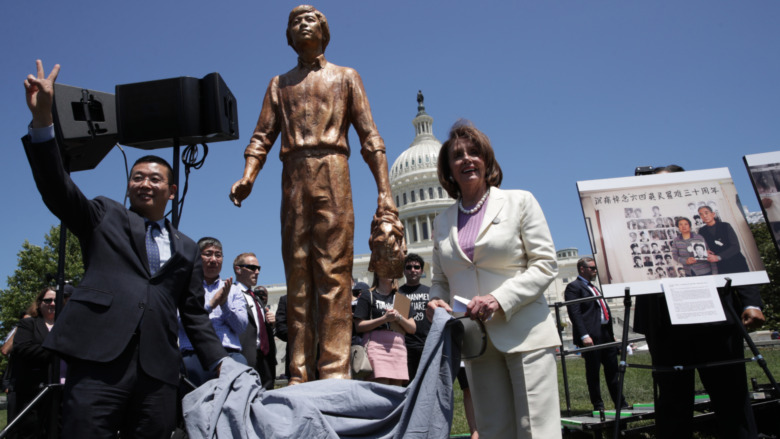The Untold Truth Of Tank Man From The Tiananmen Square Protests
In mid-1989, China was swept by protests. For almost two months, student-led, pro-democracy, and anti-corruption demonstrators had occupied Tiananmen Square in Beijing. At the end of May, the army was mobilized, and on June 4, they were given orders to clear out the protesters. "The Tiananmen Square Massacre," says Time, "changed China forever."
The images that resulted from the violence of that week are certainly lasting forever as well. Testimony to resilience and patriotism in the face of overwhelming odds. Especially the picture of one man in Tiananmen Square, armed with nothing more than his shopping, staring at a row of tanks — holding the might of the largest military on Earth at bay. A terrifyingly humble hero who people have a lot of misinformation about. Tank Man may be globally famous, but many people don't know what exactly it was he did, or what happened to him.
Protests were happening all over China
The People's Republic of China is run by the Communist Party of China, and the first few decades of the country's existence were pretty rough. After Chairman Mao Zedong steered the nascent socialist state first into the Great Leap Forward and then the Cultural Revolution, China was a nuclear power but destitute — most of the country's 1 billion people were destitute when he died in 1976. His successor was a reformer, allowing both foreign investment and some domestic innovations. The result was that China was indeed growing wealthier, says the BBC, but with it came "corruption, while at the same time raising hopes for greater political openness."
Within a few years, protests against corruption began on college campuses, and by 1989, they had grown in size and frequency and become a concern for the Communist Party. The death of a leading reformer sent tens of thousands of protesters to the streets in cities all over China. According to the Associated Press, after China's largest state-run newspaper, People's Daily, published the editorial, "'The Necessity for a Clear Stand Against Turmoil,' it described the protests as a 'well-planned plot' to overturn Communist rule" and spurred the protests into high gear.
Demonstrators began turning out in over 400 cities, and less than a month after the editorial, the Communist Party declared martial law. Two weeks later the leadership ordered the military to put down the protests.
Tank Man wasn't killed
On June 3, the People's Liberation Army (PLA, the official name of the Chinese army) was sent in to Beijing to restore order. Thousands of troops and dozens of tanks converged on Tiananmen Square. Artillery could be heard around the city and, AP reported at the time, "soldiers began firing heavily at a crowd of nearly 3,000," while a "bicyclist was dragged off and beaten by troops," and over "20 tanks and personnel carriers were moving slowly eastward from the square." The situation escalated swiftly, and more than 100 more tanks poured into the city, running over civilian vehicles and even some civilians. Protesters threw rocks and molotov cocktails, built barricades, and set fire to troop transports but were overwhelmed.
On June 5, the violence was subsiding, and the troops in Tiananmen Square were being redeployed to other areas of the city. A column of a couple dozen tanks was suddenly stopped by a lone man in a white button-up shirt and black slacks, carrying two plastic grocery bags, reports PBS. The driver, to his credit, tried to move around him a few times. "Tank Man" blocked him each time and then climbed up on the tank, knocking on the hatch. He spoke to the driver for a few minutes, then descended. Some other unidentified people ran from the sidewalk and hustled him off the street. According to History, at least 600 people were arrested that day, but Tank Man seems to have gotten away unscathed.
The tanks were actually leaving the square
The protests of 1989 were massive, and the central government responded with a near equivalent level of force. Hundreds of thousands of soldiers were deployed in and around the capital city with hundreds of tanks and armored vehicles. On June 4, soldiers surrounded the protesters at Tiananmen. They were given orders, according to PBS, not to fire immediately but that no matter what the square should be empty by 6 a.m. the next day. The protesters, understanding the circumstances, held a vote — stay and face thousands of soldiers or stay alive by leaving. "It was clear to me," eyewitness John Pomfret told PBS, "that the stay votes were much, much, much stronger."
The massacre started later, when people returned to the square to look for relatives or friends. Soldiers opened fire, chasing them away, said journalist Jan Wong. "The commander would eventually give another signal ... and they'd shoot more in the backs." Across the city barricades erected by protesters were being torn down while the protesters themselves were forcibly dispersed.
By the next morning the square was quiet. Protesters had fled, the dead and wounded removed, and the soldiers were being ordered to other parts of the city. This is when the line of tanks met a lone, grocery-carrying stranger. It may seem strange, but Tank Man stopped the tanks from leaving the scene, not from entering. And nobody will ever know why.
Nobody knows who Tank Man really was
Tank Man is one of the most famous figures in the world, even though the entire episode lasted around three minutes before two unknown people rushed him away from danger. The image of a solitary guy staring down the might of the PLA, armed with nothing more than his shopping, has become iconic. One of the photographers who captured the famous moment was a finalist for a Pulitzer prize. "My image was named one of the top 10 most memorable photos of all time," said photojournalist Jeff Widener to CNN. Tank Man is on T-shirts, posters, book and album covers, and innumerable websites — and nobody knows who he is. Nobody has ever stepped forward to claim the mantle, and no independent media or human rights group has ever confirmed his identity.
According to History, a few weeks after his now famous standoff with a row of tanks, Tank Man's identity was revealed by a British newspaper. The Sunday Express said it was 19-year-old college student Wang Weilin, who had been previously arrested for "political hooliganism." Conflicting stories suggest that Wang had been jailed or killed by the government, but the Chinese Communist Party insists they never identified Tank Man, let alone located him afterwards, and that nobody was arrested or even punished for the event.
China tried to cover up the violence
There are a great deal of unknowns about the Tiananmen Square protests — nobody really knows who Tank Man was or what happened to him, nobody really knows how many people were arrested, and nobody even really knows how many people were killed, not to mention injured. This is in very large part due to the great lengths the Chinese government went to keep such details secret. One party states, like the People's Republic of China, are universally opaque, especially during tragedies, and most especially when such tragedies are characterized by popular resistance or demonstrations.
The hotel that Stuart Franklin, a photojournalist in Beijing during the protests, was staying at "was owned and run by a branch of the military," he told National Geographic. The evening of June 4, the day the shooting started, Franklin said, "they occupied the lobby and started searching journalists and confiscating film." Fang Zheng was a student protester who ended up with his legs amputated after a tank "rolled over my legs and trousers," he said to The Guardian, "and I was dragged for a distance." Police visited him when he left the hospital, asking him "to keep quiet about the fact a tank had crushed students." Army officers visited the doctors who worked on a man killed by a stray bullet in his own home and "ordered that there should be no mention of a gunshot wound on the death certificate."
No one knows how many people died
The Chinese government claims that approximately 200 civilians died during the Tiananmen "incident," but Human Rights Watch says it was literally ten times that. The day Tank Man made his name, says The Independent, Britain's ambassador to China told his superiors in London that a high-ranking source in the Chinese government said "at least 10,000 people" were killed. Student leaders, according to The New York Times at the time, claimed "at least 500 people may have been killed," but students would later, per National Geographic, "claim up to 3,400 deaths." The initial reports of 2,600 casualties came from the Chinese Red Cross, said another New York Times article a few weeks later, but the group later recanted and said they never issued such a casualty figure.
China's leaders claim over a hundred PLA soldiers died during the ”counterrevolutionary rebellion," a number The New York Times said lacks "any evidence to support." George Washington University's National Security Archive project describes a declassified secret cable from that summer that claims "'civilian deaths probably did not reach the figure of 3,000 used in some press reports,' but believes that the figure put forward by the Chinese Red Cross of 2,600 military and civilian deaths with 7,000 wounded to be 'not an unreasonable estimate.'" The archive also holds another declassified cable, however, that says between 500 and 2,600 were killed and possible "injuries up to 10,000."
The pictures actually had to be smuggled out of China
The communist government of the People's Republic of China has, from the very start, kept a tight leash on speech and information of all kinds. Even today selling the wrong kind of books or saying the wrong things will get you jailed while the Great Firewall, what The Guardian called "the largest and most sophisticated online censorship operation in the world," rigidly monitors, restricts, and/or completely bans websites and information from all over the world from entering China. The photographers and journalists in Beijing during the 1989 protests faced huge obstacles in reporting the story to the world.
They weren't allowed on the streets, so the Tank Man pictures Charlie Cole took for Newsweek were taken from his hotel room. He told PBS Frontline that "he noticed the Chinese Public Security Bureau (PSB) watching him through binoculars" and quickly stashed his roll of film in the toilet. Not even 15 minutes later "the PSB broke through the door...took a roll of film that Cole had shot from the night before, forced him to sign a confession that he had been photographing during martial law and confiscated his passport."
Photographer Stuart Franklin told National Geographic that his Tank Man pictures were "smuggled out of the country in a box of tea." Jeff Widener's Pulitzer-finalist photos, according to CNN, were given to an exchange student who had to hide the "film in his underwear."
China bans talking about Tank Man
The Chinese Communist Party has never entertained any challenges to its authority, the protests of 1989 — especially the events at and around Tiananmen Square in June — being a tragic example from recent history. They would also be an example of current events because China censors a vast range of discussion around the protests and bans the topic of Tank Man nearly entirely. In fact, reported The World, only 15% of Beijing college students could even identify the famous picture at all.
Four people in Sichuan province were arrested in 2016 for selling bottles of liquor bearing homages to Tank Man. Flanking a cartoon man before a column of cartoon tanks are the date, "June 4, 1989," and the message, "Never forget, never give up." In 2019, the last of the four, Chen Bing, was sentenced to three-and-a-half years in jail, according to the South China Morning Post, for the crimes of "picking quarrels and provoking trouble." His family's long history of activism — his brother was actually a student protest leader at his local university in 1989 — was said to have aggravated Chen's sentence, which was the longest of the four. He refused to apologize for his actions, refused to accept the government's replacement lawyer for his, and said nothing in court but a prepared statement — "The day will come when the trauma of June 4 is confronted ... only then can truth, reconciliation, and forgiveness move forward" (via Radio Free Asia).
The protests are actually taught in Chinese schools — sort of
Good propaganda doesn't erase events entirely, it controls the narrative around the events — and China is a world leader at manipulating history. As such, some Chinese schools, explains the Globe and Mail, although decidedly not all of them, do include perfunctory references to the "Tiananmen incident" and the student protests but always through the lens of "patriotic education." Researcher Eric Fish wrote for Time, "Some textbooks whitewash the Tiananmen protests as a 'riot' instigated by black elements who were justifiably suppressed with violence, along with a small number of bystanders."
"I really feel bad for those students," a Beijing college student told Fish, "but politically speaking, maybe it was necessary." Another student said that, "Tiananmen looks bad, but maybe there were some good things. Chinese really want stability above all else."
Of course, Fish also described conversations he had in China that showed the inevitable cracks in the propaganda narrative. He asked a migrant worker his thoughts on China's government. The worker then asked Fish what he knew about June 4, but "Before I could answer, he began pantomiming machine gun fire." A high school student said that she'd heard about protesters being killed in 1989 but that "the government doesn't let us know about things like that."
Chinese use code to talk about Tiananmen
In the quarter-century since its creation, the Great Firewall has been tasked with monitoring an ever-increasing amount of subjects and individuals on ever-proliferating platforms. The most common tactics include blanket bans on searching for certain terms on Chinese search engines and blocking posts on Chinese social media containing keywords. However, Chinese still find ways to speak their minds that are just as sophisticated, and a lot more sarcastic.
When the National People's Congress moved to abolish term limits for the Chairman in 2018 (effectively keeping Xi Jinping in power forever), Chinese netizens reacted with sardonic fury such that, according to China Digital Times, Chinese social media began blocking posts and searches for dozens of new terms — like, "personality cult," "emigrate," "recover one's authority," "incapable ruler," and many more. Every year before the anniversary of Tiananmen, the censors are so busy, says NBC, that June 4 is called "internet maintenance day."
The search and post bans get increasingly ridiculous in response to the clever ways that online Chinese get around the them. As Harvard's Berkman Klein Center explains, because Chinese is a tonal language, a single word can have multiple definitions depending on how its pronounced, up to 80% of Chinese syllables have multiple meanings. Thus, after banning "ascend the throne," they also had to ban "board the plane," which people started typing instead because they sound nearly identical.
There are memorials all over the world to Tank Man
Tank Man's courageous moment impressed a world in a year full of courageous moments,as what was seen to be the collapse of communism spread throughout the world. Poland began shirking the Iron Curtain the year prior, and 1989 was seeing pro-democracy protests all over eastern Europe, Central America, as well as Asia. The Berlin Wall fell a few years later, and the Soviet Union itself not even two years later, but China weathered through, the only communist government to survive the protests of 1989 and now, according to The World, one of only five remaining communist countries in the world.
Since then, the Tiananmen Square protests and Tank Man have become internationally recognized symbols — sometimes actual, tangible symbols. They can be seen on posters and as mock tributes regularly at anti-China or pro-democracy protests all over the world but also in larger statues and memorials from Europe to the Americas. The "Monument in memoriam of Tiananmen Square Massacre victims" was unveiled in 1989 in Poland, according to Monuments of Remembrance. The world's largest permanent tributes to Tiananmen — a giant "64" statue, lying between Los Angeles and Las Vegas, (via South China Morning Post) and a full-size Tank Man replica memorial off the highway in the Mojave Desert (via the Los Angeles Times) — are actually in the U.S.
